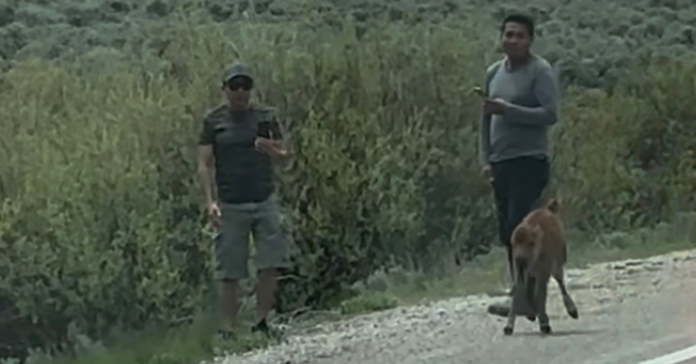Two people recently harassed a bison calf in Grand Teton National Park in Wyoming by approaching and touching it, officials said, prompting an investigation into the latest instance of park visitors overstepping boundaries with wildlife.
National Park Service rangers have asked for help in identifying the two individuals who touched the bison calf on June 4 at the southern end of Elk Ranch Flats.
A photo released by the Park Service appears to show two men — one in shorts and sunglasses, the other in long sleeves — standing close to the bison calf, which is by the side of a road.
“The safety of visitors and wildlife depends on everyone playing a critical role in being a steward for wildlife by giving them the space they need to thrive,” the Park Service said in a statement. “Their lives depend on it.”
Park regulations require visitors to stay at least 25 yards away from all wildlife, including bison, elk and deer, and at least 100 yards away from bears and wolves.
The episode was the latest to draw the ire of park officials who, for years, have warned visitors to stay away from animals and not touch them.
That caution holds particular relevance for bison calves, which can weigh 30 to 70 pounds at birth, because human interference with the animals can cause bison herds to reject the offspring.
The Park Service said that in the June 4 case, the calf was successfully reunited with its herd. Often, however, human interactions can result in having to euthanize the animal.
A bison calf had to be euthanized last month at Yellowstone National Park after a man apparently tried to help it, causing the herd to reject it, park officials said. Park rangers had “tried repeatedly to reunite the calf with the herd,” the Park Service said, but those efforts failed.
In 2018, a video of a man harassing a bison at Yellowstone National Park by goading and lunging at it got widespread attention, prompting rangers to arrest him.
In 2016, a bison calf was euthanized after it was placed in the back of an S.U.V. and rejected by its herd. And in 2015, a woman was injured while trying to take a selfie near a bison.
It was not immediately clear what charges, if any, the men being sought could face.
Chad Kremer, the president of the National Bison Association and a bison herd manager in South Dakota, said most instances of people getting close to calves are rooted in well-meaning intentions: They want to help a stray calf find its way to the herd or get out of difficult terrain.
But such efforts pose risks to the animal and the people, Mr. Kremer said.
“Even if they do appear to be lost or abandoned, typically that’s not the case,” he said. “When you begin intervening, it will just compound the problem.”
Female bison sometimes put young calves in an area, leave them and go off grazing before coming back for their offspring, Mr. Kremer said. But if someone picks up the calf or moves it, that process is disrupted and the female bison may be deterred from returning because of the human scent on the animal.
Visitors can also be in danger, given that bison are the largest mammal in North America.
Male bison, also called bulls, weigh up to 2,000 pounds and stand six feet tall. Females, or cows, weigh up to 1,000 pounds and reach a height of four to five feet.
It is difficult to track the frequency in which people interfere with bison calves, Mr. Kremer said, but it is possible that there is more awareness of such episodes because of news coverage.
An uptick in National Park visitations — 312 million recreation visits were recorded in 2022 compared with 297 million recreation visits in 2021 — could also be a factor.
Credit: Source link

















